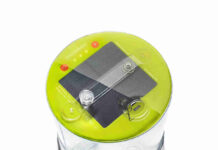
Chemists at the University at Buffalo have synthesized a new class of photosensitizing dyes that greatly increase the efficiency of light-driven systems that produce two kinds of green energy: Solar electricity and clean-burning hydrogen fuel.
On a commercial scale, these advancements could form the basis of cost-effective technologies to power everything from household appliances to hydrogen vehicles.
To produce electricity, the dyes-called chalcogenorhodamine dyes-operate as part of a Grätzel-type solar cell that converts sunlight into an electric current. When sunlight strikes the dyes, the energy knocks loose electrons in the dyes that travel through the solar cell, forming the current.
The mechanism for producing hydrogen begins the same way: Sunlight strikes the dyes, freeing electrons. But instead of forming a current, the electrons flow into a catalyst, where they drive a chemical reaction that splits water into its basic elements: hydrogen and oxygen.
In laboratory tests, scientists at UB and the University of Rochester have shown that these chalcogenorhodamine systems produce hydrogen at unprecedented rates, in part because the dyes absorb light more intensely and transfer their electrons more efficiently than conventional dyes.
The research team, led by UB Professor Michael Detty and University of Rochester Professor Richard Eisenberg, reported some of their findings in the Journal of the American Chemical Society in October 2010.
Detty, who worked in the private sector for 17 years before joining UB’s faculty, hopes his research will lead to the development of better commercial technologies for producing solar electricity and hydrogen on demand.
“Sunlight in one hour could power the world for a year, but we don’t tap into it for either electricity or for making solar fuels,” Detty said, explaining the importance of his work. “Plants use sunlight to make their own fuels. Humans don’t. We use oil. So if we want to have energy independence, it will come from solar.”
UB has received a Notice of Allowance from the U.S. Patent and Trademark Office approving the issue of a patent to cover the composition of the dyes. A separate patent application seeks to protect the dyes’ use in hydrogen evolution and lists Detty and Eisenberg, along with Brandon Calitree, Alexandra Orchard and Theresa McCormick, as co-inventors of the process.
The collaborators found that chalcogenorhodamines work efficiently in homogenous hydrogen-production systems that employ cobalt as the catalyst, as well as in heterogeneous systems that employ platinum deposited on titanium dioxide as the catalyst.
UB’s Office of Science, Technology Transfer and Economic Outreach is handling licensing of the discoveries.



